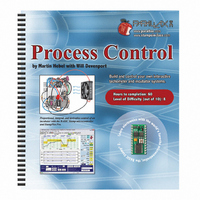122-28176 Parallax Inc, 122-28176 Datasheet - Page 167

122-28176
Manufacturer Part Number
122-28176
Description
GUIDE STUDENT PROCESS CONTROL
Manufacturer
Parallax Inc
Specifications of 122-28176
Accessory Type
Manual
Product
Microcontroller Accessories
Lead Free Status / RoHS Status
Contains lead / RoHS non-compliant
For Use With/related Products
Propeller Education (PE) Kit
Lead Free Status / RoHS Status
Lead free / RoHS Compliant, Contains lead / RoHS non-compliant
- Current page: 167 of 330
- Download datasheet (11Mb)
Does the voltage eventually start to decrease?
After the PWM has been applied, the BASIC Stamp output is high impedance, limiting
the loss of electrons on the charged capacitor. The charge is also lost through the ADC
sampling the voltage and leakage of the capacitor. Both of these are minimal because of
the very high impedance of the ADC input and the dielectric, or insulation, used in the
capacitor.
Can this average voltage be used to drive the fan even when the BASIC Stamp is busy
performing other tasks? Unfortunately not. The high current draw (90 mA) will quickly
bleed the charge off the capacitor. Let's test this using a 1 MΩ load, which at 5 V would
have a current draw of 0.005 mA or 5 µA – MUCH less than the current draw of the fan.
What occurs to the voltage with R
decreases as shown in Figure 5-11. The rate at which the voltage decreases can be
calculated. The time-constant (τ) of an RC network is approximately 1.1 times the
resistor value and the capacitor value or:
In this case,
While we won't get much deeper into the math, the charge and discharge of a capacitor
requires 5 time constants (5 τ) for the capacitor to nearly fully charge or discharge.
For this circuit:
√
√
Connect the 1 MΩ resistor, R
Repeat the stepped PWM test with a sample number of 25.
τ = 1.1 RC
τ = 1.1(1 MΩ)(0.68 µF) = 0.748 seconds.
5 τ = 5 (0.748 s) = 3.74 seconds.
L
L
, as shown earlier in Figure 5-11.
in place? The voltage on the capacitor rapidly
Related parts for 122-28176
Image
Part Number
Description
Manufacturer
Datasheet
Request
R

Part Number:
Description:
MANUAL FOR SUMOBOT
Manufacturer:
Parallax Inc
Datasheet:

Part Number:
Description:
GUIDE STUDENT SMART SENSORS
Manufacturer:
Parallax Inc
Datasheet:

Part Number:
Description:
MANUAL PROPELLER
Manufacturer:
Parallax Inc
Datasheet:

Part Number:
Description:
LEAD WIRES FLYING CABLE III/IV
Manufacturer:
Xilinx Inc
Datasheet:

Part Number:
Description:
BOARD ADAPTER AND FLY LEADS
Manufacturer:
Xilinx Inc
Datasheet:

Part Number:
Description:
PLATFORM CABLE USB II
Manufacturer:
Xilinx Inc
Datasheet:

Part Number:
Description:
KIT STARTER COOLRUNNER-II BUNDLE
Manufacturer:
Xilinx Inc
Datasheet:

Part Number:
Description:
Microcontroller Modules & Accessories DISCONTINUED BY PARALLAX
Manufacturer:
Parallax Inc

Part Number:
Description:
Microcontroller Modules & Accessories DISCONTINUED BY PARALLAX
Manufacturer:
Parallax Inc

Part Number:
Description:
BOOK UNDERSTANDING SIGNALS
Manufacturer:
Parallax Inc
Datasheet:

Part Number:
Description:
BOARD EXPERIMENT+LCD NX-1000
Manufacturer:
Parallax Inc
Datasheet:

Part Number:
Description:
IC MCU 2K FLASH 50MHZ SO-18
Manufacturer:
Parallax Inc
Datasheet:












